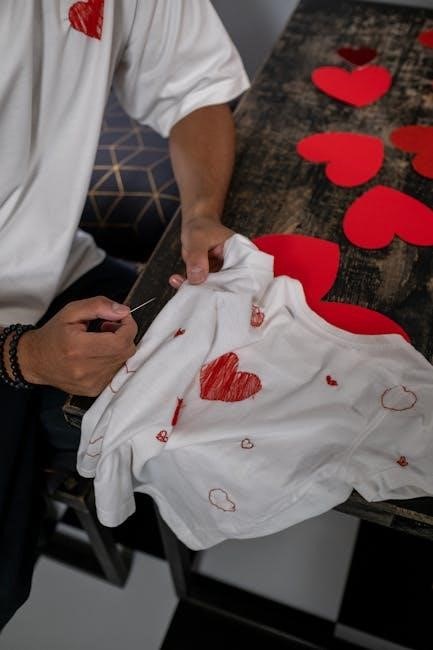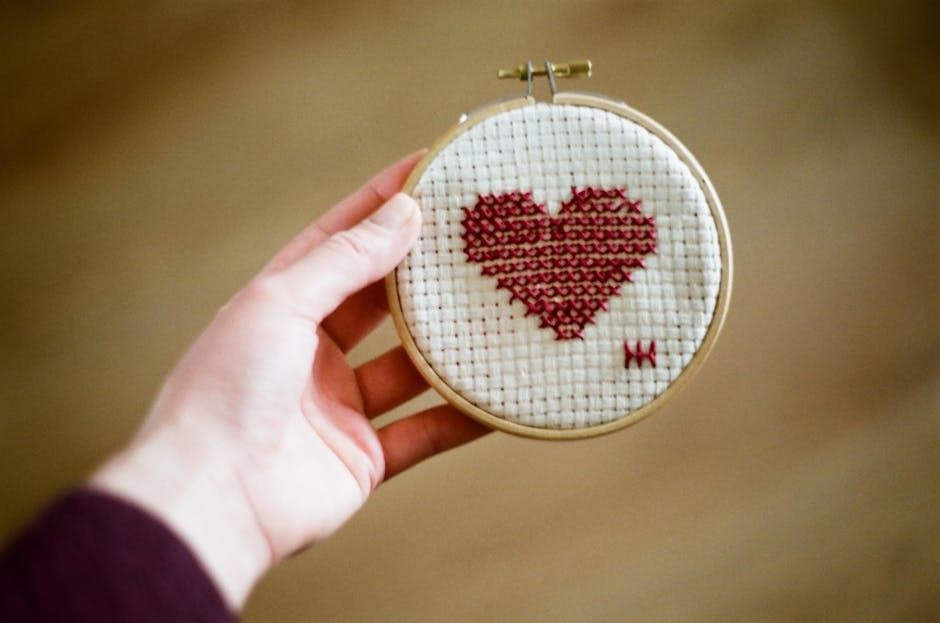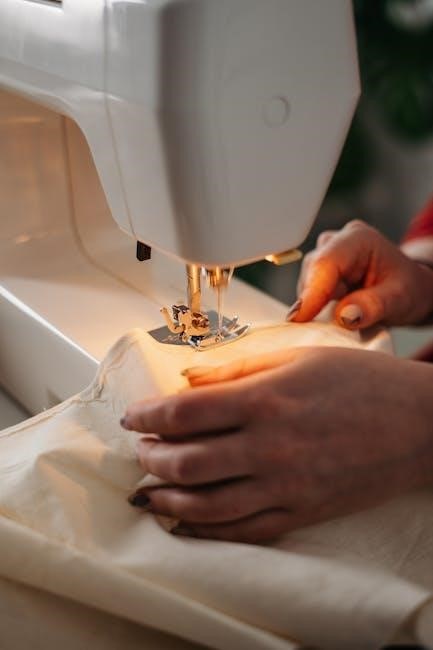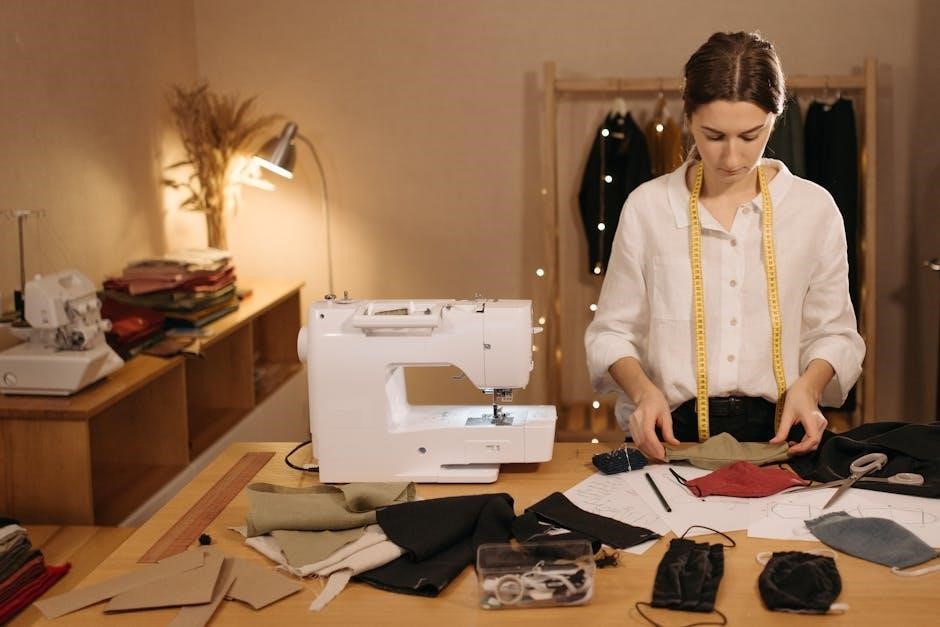Hand sewing is a traditional skill offering versatility and creativity in fabric manipulation. It involves using basic stitches like running, backstitch, and whipstitch to mend or craft decorative elements, essential for beginners and experienced sewists alike.
Importance of Hand Sewing in Modern Times
Hand sewing remains a valuable skill in today’s fast-paced world, offering practicality, creativity, and sustainability. It allows for personalized repairs, extending the life of garments and reducing waste. Despite the convenience of sewing machines, hand sewing provides precision for delicate fabrics and intricate details. It also serves as a creative outlet, enabling crafters to embroidery or customize textiles. In a culture emphasizing DIY and self-sufficiency, hand sewing empowers individuals to mend and create without reliance on machinery. Additionally, it fosters patience and mindfulness, making it a therapeutic hobby. Whether for functional repairs or artistic expression, hand sewing continues to be a timeless and versatile craft, bridging tradition with modern needs.
Applications of Basic Hand Sewing Stitches
Basic hand sewing stitches are versatile tools with a wide range of applications. The running stitch is ideal for gathering fabric or creating simple seams, while the backstitch is perfect for outlining designs or reinforcing seams. Whipstitch excels at hemming and seaming, overcast stitch prevents fabric fraying, and blanket stitch decorates and secures edges. Slip stitch is great for invisible seams and attaching linings, and basting stitch temporarily holds fabric in place. These stitches are essential for repairing clothes, mending torn seams, and extending garment life. Beyond practicality, they enhance fabric with decorative elements, adding personal touches to projects. Whether for functional repairs or creative embroidery, these stitches form the foundation of countless sewing tasks, making them indispensable for both beginners and experienced crafters. Their applications span from everyday mending to intricate, artistic designs.

Materials Needed for Basic Hand Sewing
The essential materials include a sharp sewing needle, all-purpose thread, cotton fabric, and basic tools like scissors and an iron for pressing seams and edges.
Essential Tools: Needles, Threads, and Fabrics
The foundation of hand sewing lies in having the right tools. A sharp sewing needle is indispensable, as it allows for precise stitching. Choose a size 10 sharp needle for general purposes; All-purpose sewing thread is another necessity, available in cotton or polyester blends, suitable for most fabrics. Cotton muslin fabric is ideal for practice, while other natural fabrics like linen or silk can be used for specific projects. Fabric shears or scissors are essential for cutting fabric and thread accurately. These tools form the core of hand sewing, enabling you to master basic stitches and complete various sewing tasks effectively.
Optional Tools: Scissors, Iron, and Sewing Aids
While not mandatory, certain tools can enhance your hand sewing experience. Sharp fabric shears or dedicated thread snips are ideal for cutting fabric and thread neatly. An iron and ironing board are useful for pressing seams and stabilizing fabric, ensuring crisp folds and professional finishes. Sewing aids like thimbles protect your fingers from needle pricks, while a seam ripper helps correct mistakes; These tools, though optional, can significantly improve the accuracy and efficiency of your hand sewing projects. They allow for better control and provide a more polished outcome, making them worthwhile additions to your sewing kit for both convenience and precision.

Basic Hand Sewing Stitches
Mastering basic hand sewing stitches is essential for any sewing project. From the running stitch to the backstitch, whipstitch, and overcast stitch, these foundational techniques provide versatility and strength for mending, hemming, and decorative purposes, forming the backbone of hand sewing skills.
Running Stitch: The Foundation of Hand Sewing
The running stitch is the most basic and versatile stitch in hand sewing, serving as the foundation for all other stitches. It involves inserting the needle in and out of the fabric in a straight line, creating a series of small, even straight stitches. This stitch is commonly used for basting, gathering fabric, or creating simple seams. To execute a running stitch, begin by bringing the needle up through the fabric, then insert it back down a short distance away, repeating this process to form a straight line of stitches. The running stitch is easy to learn and is an essential skill for any beginner, making it a crucial starting point for mastering hand sewing techniques.
Backstitch: Creating Strong and Visible Lines
The backstitch is a strong and visible stitch often used to create straight lines or outlines in hand sewing. It is particularly useful for sewing seams that require durability, as well as for embroidery and decorative purposes. To sew a backstitch, insert the needle into the fabric and bring it up a short distance ahead. Then, reinsert the needle behind the previous stitch, moving backward to create a reverse motion. This stitch is ideal for projects where a bold, defined line is desired, such as in garment construction or embellishing fabric. The backstitch is also a foundational stitch for more complex techniques, making it an essential skill for both beginners and experienced sewists.
Whipstitch: A Simple Hemming Stitch
The whipstitch is a straightforward and efficient hand-sewing stitch commonly used for hemming and seaming. It involves making short, diagonal stitches over the edge of the fabric to secure it in place. This stitch is particularly useful for finishing raw edges to prevent fraying and for joining two pieces of fabric together. To sew a whipstitch, bring the needle over the edge of the fabric and insert it diagonally into the fabric on the other side. Repeat this process, moving along the edge in a consistent rhythm. The whipstitch is ideal for quick repairs, hemming loose edges, and sewing thicker fabrics like denim or canvas. Its simplicity makes it a great stitch for beginners, while its functionality ensures it remains a go-to technique for experienced sewists.
Overcast Stitch: Preventing Fraying
The overcast stitch is a fundamental hand-sewing technique designed to prevent fabric fraying by securing the raw edges. This stitch is particularly useful for fabrics prone to unraveling, such as cotton, linen, and knits. To execute the overcast stitch, insert the needle diagonally into the fabric, moving from the top to the bottom, and then bring it back up on the other side. The process creates a series of small, overlapping loops that encapsulate the edge of the fabric. The overcast stitch is often used before applying a hem or as a standalone finish for seams in garments and home textiles. It is a simple yet effective method to ensure durability and a professional finish, making it an essential skill for sewists of all levels.
Blanket Stitch: Decorating and Securing Edges
The blanket stitch is a versatile and decorative stitch used to secure and finish fabric edges, particularly on blankets, home decor items, and thicker fabrics; It is characterized by its visible, even loops on one side of the fabric, creating a clean and polished appearance. To execute the blanket stitch, insert the needle at a 45-degree angle, bringing it up and over the edge of the fabric. This stitch is not only functional but also adds a decorative element, making it ideal for projects like baby blankets or decorative pillows. The blanket stitch is easy to learn and works well on straight or curved edges, ensuring a professional and attractive finish for various sewing projects. It is a must-learn stitch for sewists of all skill levels.
Slip Stitch: Invisible Seams and Attaching Lining
The slip stitch is a nearly invisible stitch used to join two edges of fabric together or to attach linings without leaving visible stitches. It is ideal for closing seams on finished projects, such as pillows or garments, where a clean appearance is desired. To perform the slip stitch, bring the needle up through the folded edge of one fabric, then insert it into the opposite edge, directly across from where it emerged. This stitch is particularly useful for attaching linings in bags, jackets, or home decor items. The slip stitch creates a strong yet discreet bond, making it essential for projects requiring a professional finish. It is a must-learn stitch for sewists aiming to achieve polished results.
Basting Stitch: Temporary Holding of Fabric
The basting stitch is a temporary stitch used to hold fabric layers in place before permanent sewing. It is typically done by hand or machine, using long, loose stitches that can be easily removed. This stitch is essential for maintaining fabric alignment during complex projects or when working with delicate materials. Basting is also useful for tracing pattern markings, such as pocket placements or hemlines, onto fabric. Unlike the running stitch, basting stitches are intentionally left loose to allow for adjustments. They prevent fabric from shifting or stretching, ensuring accuracy when sewing. Once the final stitches are in place, the basting thread is simply pulled out. This technique is a time-saving and practical tool for sewists of all skill levels.
Blind Hem Stitch: Nearly Invisible Hems
The blind hem stitch is a nearly invisible stitch used to create professional-looking hems. It is ideal for garments where a visible hemline is undesirable, such as on pants, skirts, or curtains. This stitch involves small, diagonal stitches on the hem’s edge, with the needle picking up only a tiny bit of fabric on the garment’s main body. The result is a nearly invisible seam, making it perfect for delicate or formal fabrics. The blind hem stitch can be done by hand or with a sewing machine, though hand stitching offers more control. It is a versatile technique that blends seamlessly into the fabric, providing a clean and polished finish to any project.

Common Uses of Hand Sewing Stitches
Hand sewing stitches are essential for hemming clothes, repairing garments, and adding decorative elements. They extend the life of fabrics and enhance their aesthetic appeal with precision and creativity.
Hemming Clothes: A Practical Application
Hemming clothes is one of the most practical uses of hand sewing stitches. It involves folding and stitching the raw edges of fabric to create a finished edge, preventing fraying and extending garment life; The whipstitch and overcast stitch are commonly used for this purpose, as they secure the edge effectively. For a nearly invisible hem, the blind hem stitch is preferred, especially on delicate or heavy fabrics. Hand hemming allows for precise control, making it ideal for tailored garments or repairing existing hems. It is a skill that combines functionality with creativity, ensuring clothes fit well and last longer. With practice, hand hemming becomes a quick and efficient way to maintain and refresh your wardrobe.
Repairing and Mending: Extending Garment Life
Repairing and mending clothes is a practical application of hand sewing that extends the life of garments. Simple stitches like the running stitch and whipstitch are often used to fix torn seams or loose buttons. The blind hem stitch is ideal for nearly invisible repairs on delicate fabrics. Hand mending not only saves money but also reduces waste, promoting sustainability. Common repairs include closing small tears, reinforcing stress points, and reattaching detached parts like buttons or zippers. With basic hand sewing skills, anyone can breathe new life into worn or damaged clothing, preserving favorite items and maintaining their quality. Regular mending also prevents minor issues from becoming major problems, ensuring garments remain functional and stylish for years to come.
Decorative Purposes: Enhancing Fabric with Stitches
Hand sewing stitches are not only functional but also serve as a creative way to enhance fabric. Decorative stitches like the blanket stitch and satin stitch add visual interest and texture to projects. Embroidery stitches, such as the French knot and lazy daisy, allow for intricate designs and patterns. These stitches can be used to embellish clothing, home decor, or handmade crafts. By varying thread colors and stitch lengths, sewists can create unique and personalized designs. Decorative hand sewing is a great way to express creativity and give projects a distinctive touch. Whether it’s adding a border or creating intricate motifs, decorative stitches transform fabric into something truly special and visually appealing. This art form combines practicality with aesthetic beauty, making it a cherished skill for crafters and sewists alike.

Tips for Beginners
Start with simple stitches like running and backstitch. Use sharp needles and quality thread for better control. Practice on scrap fabric to build confidence and precision in your technique.
Choosing the Right Needle and Thread
Selecting the appropriate needle and thread is crucial for successful hand sewing. Use sharp, thin needles for general sewing, and blunt needles for thicker fabrics or heavy materials. Thread choice depends on fabric type—cotton for natural fibers and polyester for synthetic. Always match thread color to fabric for seamless results. Avoid thick or fuzzy threads that may cause puckering. For delicate fabrics, use fine needles and lightweight threads. Proper tools ensure even stitches and prevent fabric damage. Keep a variety of needles and threads on hand for different projects. Using the right materials enhances stitching quality and durability. This foundation is key to mastering basic hand sewing stitches effectively.
Practicing Stitches on Scrap Fabric
Practicing hand sewing stitches on scrap fabric is essential for mastering techniques. Start with simple stitches like the running or whipstitch to build confidence. Use inexpensive cotton muslin or leftover fabric to experiment without waste. Begin by tracing straight lines or basic shapes with a pencil, then sew along them. This helps develop even stitching and control. As you progress, practice more complex stitches like the backstitch or blanket stitch. Printable practice sheets, available in PDF guides, provide structured exercises for improving accuracy. Regular practice on scrap fabric ensures that your stitches are consistent and neat, preparing you for more intricate projects. This hands-on approach is the best way to refine your skills and gain proficiency in basic hand sewing stitches.

Resources for Learning
Download free PDF guides and printable practice sheets to master basic hand sewing stitches. Online tutorials and video demonstrations provide step-by-step instructions, ideal for beginners to improve their skills.
PDF Guides and Printable Practice Sheets
Enhance your hand sewing skills with downloadable PDF guides and printable practice sheets. These resources offer detailed instructions for mastering basic stitches like the running stitch, backstitch, and whipstitch. Perfect for beginners, they provide step-by-step tutorials and diagrams to ensure proper technique. Printable sheets allow you to practice stitching on paper, helping you build muscle memory and confidence. Many guides are free and easily accessible online, making learning convenient. Whether you’re mending clothes or creating decorative embroidery, these tools are invaluable. They often include tips for choosing the right needles and threads, ensuring your stitches are even and secure. With these resources, you can progress from simple repairs to intricate designs, making hand sewing accessible and enjoyable for all skill levels.
Online Tutorials and Video Demonstrations
Online tutorials and video demonstrations are excellent resources for mastering basic hand sewing stitches. Platforms like YouTube and crafting websites offer step-by-step guides, making it easier to learn stitches like the running stitch, backstitch, and whipstitch. Videos provide clear visuals, allowing you to see how fabric, needle, and thread interact. Many tutorials are designed for beginners, breaking down complex techniques into simple, digestible steps. Some videos also cover tips for choosing the right tools and materials, ensuring your stitches are consistent and secure. Interactive lessons and close-up shots help you understand proper tension and spacing. Whether you’re mending clothes or creating decorative embroidery, these resources make learning hand sewing accessible and engaging. They are a great supplement to PDF guides, offering a dynamic way to improve your skills.
Mastering basic hand sewing stitches opens doors to creative projects and practical repairs. Regular practice enhances skill and confidence, making hand sewing a lifelong, valuable skill.
Mastering Basic Stitches for Future Projects
Mastering basic hand sewing stitches is the cornerstone of unlocking more complex sewing projects. These foundational stitches, such as the running stitch, backstitch, and whipstitch, are essential for constructing garments, home decor, and embroidery. By practicing these stitches, sewists can build confidence and precision, enabling them to tackle intricate patterns and designs. Resources like PDF guides and video tutorials provide step-by-step instructions, making it easier to refine techniques. As skills improve, sewists can explore creative applications, such as decorative stitching or upcycling old fabrics. Consistent practice ensures that these stitches become second nature, paving the way for future projects that require both functionality and artistry. The journey of mastering these stitches is a rewarding process that enhances sewing proficiency and creativity.
Encouragement to Continue Practicing
Consistent practice is key to mastering basic hand sewing stitches. Celebrate small achievements, like completing a running stitch or perfecting a backstitch, to stay motivated. Remember, every stitch brings you closer to creating beautiful, handmade items. Don’t be discouraged by initial mistakes—they are part of the learning process. With patience, your skills will improve, and sewing will become a relaxing, creative outlet. Utilize resources like PDF guides and video tutorials to refine your techniques. Keep experimenting with different fabrics and projects to apply your newfound skills. The satisfaction of crafting something with your own hands is incredibly rewarding. Keep stitching, and enjoy the journey of becoming a skilled sewist!